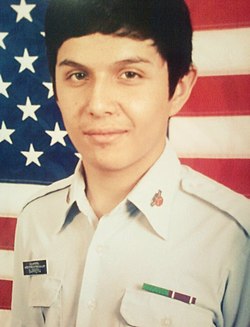 Civil Air Patrol (CAP) is a Congressionally chartered, federally supported, non-profit corporation that serves as the official civilian auxiliary of the United States Air Force (USAF).[2] CAP is a volunteer organization with an aviation-minded membership that includes people from all backgrounds, lifestyles, and occupations. It performs three congressionally assigned key missions: emergency services, which includes search and rescue (by air and ground) and disaster relief operations; aerospace education for youth and the general public; and cadet programs for teenage youth. In addition, CAP has recently been tasked with homeland security and courier service missions. CAP also performs non-auxiliary missions for various governmental and private agencies, such as local law enforcement and the American Red Cross. The program is established as an organization by Title 10 of the United States Code and its purposes defined by Title 36. While CAP is sponsored by the USAF, it is not an operating reserve component under the Air Force or the federal government. Since CAP is not a reserve component of a uniformed service of the military and its membership is made up of volunteer civilians, CAP members are not subject to the laws governed by the Uniform Code of Military Justice.
Civil Air Patrol (CAP) is a Congressionally chartered, federally supported, non-profit corporation that serves as the official civilian auxiliary of the United States Air Force (USAF).[2] CAP is a volunteer organization with an aviation-minded membership that includes people from all backgrounds, lifestyles, and occupations. It performs three congressionally assigned key missions: emergency services, which includes search and rescue (by air and ground) and disaster relief operations; aerospace education for youth and the general public; and cadet programs for teenage youth. In addition, CAP has recently been tasked with homeland security and courier service missions. CAP also performs non-auxiliary missions for various governmental and private agencies, such as local law enforcement and the American Red Cross. The program is established as an organization by Title 10 of the United States Code and its purposes defined by Title 36. While CAP is sponsored by the USAF, it is not an operating reserve component under the Air Force or the federal government. Since CAP is not a reserve component of a uniformed service of the military and its membership is made up of volunteer civilians, CAP members are not subject to the laws governed by the Uniform Code of Military Justice.
Membership in the organization consists of cadets ranging from 12 to 20 years of age, and senior members 18 years of age and up. These two groups each have the opportunity to participate in a wide variety of pursuits; the Cadet program contributes to the development of the former group with a structured syllabus and an organization based upon United States Air Force ranks and pay grades, while the older members serve as instructors, supervisors, and operators. All members wear uniforms while performing their duties.
Nationwide, CAP is a major operator of single-engine general aviation aircraft, used in the execution of its various missions, including orientation flights for cadets and the provision of significant emergency services capabilities. Because of these extensive flying opportunities, many CAP members become licensed pilots.
The hierarchical and military auxiliary organization is headed by the National Headquarters (with authority over the national organization) followed by eight regional commands and 52 wings (each of the 50 states plus Washington, D.C. and Puerto Rico). Each wing supervises the individual groups and squadrons that comprise the basic operational unit of the organization.
Source: http://en.wikipedia.org/wiki/Civil_Air_Patrol
Links:
- Air Force targeting 12 – 18 year olds
- Civil Air Patrol: Facts, Discussion Forum, and Encyclopedia Article
- Civil Air Patrol - United States Air Force Auxiliary
- Civil Air Patrol MOU with Drug Enforcement Administration
- Addicted to Drugs: The Civil Air Patrol and Operation Drop-In
- Civil Air Patrol Drugs Demand Induction | Abuse of Authority | Misconduct
- Paramilitary: Facts, Discussion Forum, and Encyclopedia Article
##
Revised 11/04/2022
Civil Air Patrol: Facts, Discussion Forum, and Encyclopedia Article







